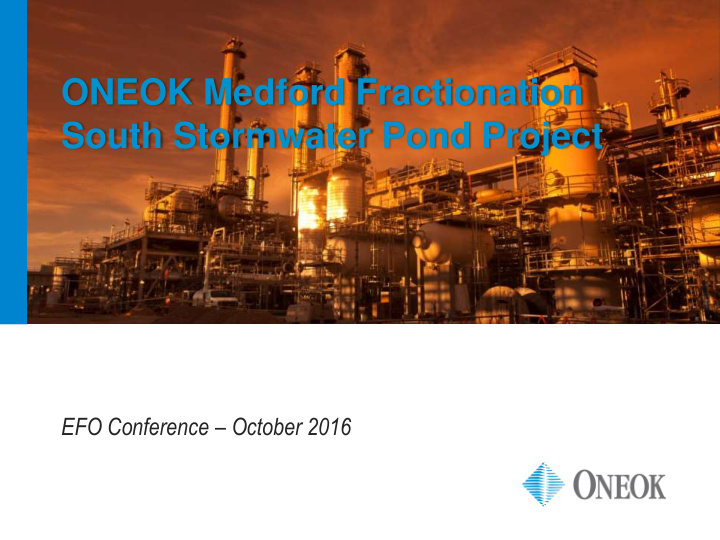



ONEOK Medford Fractionation South Stormwater Pond Project EFO Conference – October 2016
Details The South Storm Water Pond was originally built over 40 years ago. • Over time, sediment from the surrounding terrain reduced the volume of the pond by approximately 16,000 cubic yards. Consequently, the pond required excavating and rework to enlarge its • capacity and to improve its potential spill protection capabilities. • The pond now can contain approximately 4.1 million gallons, which increases the capacity by over 33% of its original size. • The new pond outlet was designed with a 24” diameter slide gate that is maintained closed. In the event of a significant spill, the liquids will be contained within the • pond, preventing contaminants from leaving the site. In addition, during rainfalls, the pond can be utilized for retention to aid in the prevention of flooding downstream of the facility. Page 2
Details Sediment Land Application Study was undertaken to determine if • contaminants were present in the sediment and the feasibility of land applying the excavated material. • The Study revealed the sediment could be characterized as non- hazardous. • All results were favorable. The sediment was applied and disked into the soil. It is now part of the • top soil and crops have been planted on the acreage to reduce erosion. • By land applying the sediment, we essentially returned eroded soil back to its original location, we didn’t consume landfill space, and we saved over $650,000 in transport and disposal fees. Page 3
Details • The channel was designed to reduce the water velocity, allowing for the suspended solids to settle in the channel prior to reaching the pond. • Ultimately, the water quality at the pond discharge point has been improved due to controlled discharge velocities and a reduction of turbidity in the pond. • In addition, the channel was designed so that small dirt work equipment, such as a skid-steer loader, can maneuver the channel sides and bottom, allowing for the removal of the sediment preventing it from returning to the pond bottom. Page 4
Project Scope • Phase One - Sediment Land Application Study • Phase Two - Pond Construction • Managed, designed, and constructed by Burns & McDonnell Engineering. • The pond upgrade provides additional storm water runoff capacity as well as tertiary containment for potential spills. • The project involved excavation, land application of the excavated material, inlet and outlet reconstruction, and miscellaneous piping installations. Page 5
Environomental Benefits Improved downstream water quality • Additional pond storage capacity for potential spills and storm • water retention • Reduced off-site waste disposal and beneficial reuse of sediment/soil Page 6
Project Cost • Project Total Cost: $1,020,000 • Excavation and Sediment Land Application: $695,000 • Sediment Basin: $150,000 • Outlet Structure: $75,000 • Timber Mats, Safety Precautions, and Incidentals: $100,000 Page 7
Page 8
Page 9
Recommend
More recommend